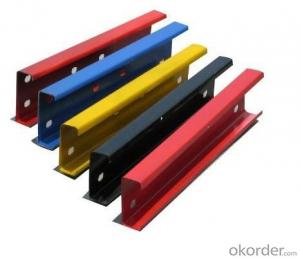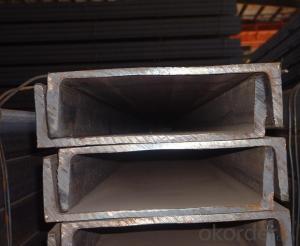U-channel JIS Standard with Different Sizes Hot Rolled
- Loading Port:
- Tianjin
- Payment Terms:
- TT OR LC
- Min Order Qty:
- 25 m.t.
- Supply Capability:
- 2000 m.t./month
OKorder Service Pledge
OKorder Financial Service
You Might Also Like
Product Description:
OKorder is offering U-channel at great prices with worldwide shipping. Our supplier is a world-class manufacturer of steel, with our products utilized the world over. OKorder annually supplies products to European, North American and Asian markets. We provide quotations within 24 hours of receiving an inquiry and guarantee competitive prices.
Product Applications:
1.The JIS channel can be devided into two kinds, namely common channel steel and light channel steel. The sizes of hot rolled common channel steel range from 5# to 40#. Meanwhile, the channel steel can be divided into cold forming sectional equal channel steel, cold forming sectional unequal channel steel, cold forming inner edge channel steel and outer edge channel steel.
2.The JIS channel is usually used for arch-itechtural structure, and they could be welded in order to support or hang a vari-ety of facilities. They are also usually used in combination with I beam. The channel steel with sizes under 14# is usually applied to construction engineering, as purline, while the channel steel with sizes above 16# is more likely to be used in building vehicle chassis structure and mechanical structure. Furthermore, the channel steel in sizes above 30# are target at building bridge structure, as tension bar.
Product Advantages:
OKorder's U-channel are durable, strong, and resist corrosion.
Main Product Features:
· Premium quality
· Prompt delivery & seaworthy packing (30 days after receiving deposit)
· Corrosion resistance
· Can be recycled and reused
· Mill test certification
· Professional Service
· Competitive pricing
Product Specifications:
1.We are able to provide channel steel of top quality at attractive price.
2.Our products of channel steel have passed ISO9001:2008 Quality Management System Certification.
Alloy No | Grade | Element (%) | |||||
C | Mn | S | P | Si | |||
Q235 | B | 0.12—0.20 | 0.3—0.7 | ≤0.045 | ≤0.045 | ≤0.3 | |
Alloy No | Grade | Yielding strength point( Mpa) | |||||
Thickness (mm) | |||||||
≤16 | >16--40 | >40--60 | >60--100 | ||||
≥ | |||||||
Q235 | B | 235 | 225 | 215 | 205 | ||
Alloy No | Grade | Tensile strength (Mpa) | Elongation after fracture (%) | ||||
Thickness (mm) | |||||||
≤16 | >16--40 | >40--60 | >60--100 | ||||
≥ | |||||||
Q235 | B | 375--500 | 26 | 25 | 24 | 23 | |
FAQ:
Q1: How soon can we receive the product after purchase?
A1: Within three days of placing an order, we will begin production. The specific shipping date is dependent upon international and government factors, but is typically 7 to 10 workdays.
Q2: What makes stainless steel stainless?
A2: Stainless steel must contain at least 10.5 % chromium. It is this element that reacts with the oxygen in the air to form a complex chrome-oxide surface layer that is invisible but strong enough to prevent further oxygen from "staining" (rusting) the surface. Higher levels of chromium and the addition of other alloying elements such as nickel and molybdenum enhance this surface layer and improve the corrosion resistance of the stainless material.
Q3: Can stainless steel rust?
A3: Stainless does not "rust" as you think of regular steel rusting with a red oxide on the surface that flakes off. If you see red rust it is probably due to some iron particles that have contaminated the surface of the stainless steel and it is these iron particles that are rusting. Look at the source of the rusting and see if you can remove it from the surface.
Images:


- Q: Can steel channels be used for supporting signage and billboards?
- Yes, steel channels can be used for supporting signage and billboards. Steel channels are known for their strength and durability, making them suitable for providing structural support to hold and secure various types of signage and billboards.
- Q: What are the considerations for steel channel connections to timber structures?
- When considering steel channel connections to timber structures, there are several important factors to keep in mind. Firstly, it is crucial to ensure that the connection is structurally sound and able to withstand the required loads and forces. This involves carefully calculating and designing the connection to ensure that it can bear the expected load without failure. Secondly, compatibility between steel and timber should be considered. Different materials have different expansion and contraction rates, so provisions must be made to accommodate these movements and prevent any potential issues, such as splitting or excessive stress on the connection. Additionally, the connection should be designed to prevent corrosion, as steel is susceptible to rusting. Proper measures, such as using protective coatings, galvanizing, or isolating materials, should be implemented to minimize the risk of corrosion and ensure the long-term durability of the connection. Lastly, it is important to follow applicable building codes and regulations when designing and constructing steel channel connections to timber structures. These codes provide guidelines and standards that must be adhered to in order to ensure the safety and structural integrity of the connection.
- Q: How do steel channels contribute to sound insulation?
- Steel channels can contribute to sound insulation by creating a barrier between the source of the sound and the surrounding environment. The use of steel channels helps to absorb and dampen sound vibrations, reducing the transmission of noise through walls and ceilings. Additionally, the rigid structure of steel channels helps to prevent the resonance and amplification of sound waves, further enhancing sound insulation.
- Q: How to connect channel steel and round steel?
- Vertical welding of channel steel and round bar axis:First, the channel steel, channel cut, need to connect the length of the arc shaped gap, and then again and round steel arc surface welding, welding before the two kinds of materials to rust, and full welding.
- Q: How do steel channels contribute to the durability of a structure?
- Steel channels contribute to the durability of a structure by providing structural support and reinforcement. They help distribute the weight and load of the structure evenly, reducing the risk of structural failure. Additionally, steel channels are highly resistant to corrosion, fire, and extreme weather conditions, which enhances the longevity and stability of the structure.
- Q: Can steel channels be used in overhead crane systems?
- Yes, steel channels can be used in overhead crane systems. Steel channels provide strength and durability, making them suitable for supporting the weight of the crane and the loads it carries. They can be used as structural beams for constructing the crane runway, bridge girders, and support structures, ensuring safe and efficient operation of the overhead crane system.
- Q: Can steel channels be used for load-bearing walls?
- No, steel channels are typically not used for load-bearing walls in traditional construction methods. Load-bearing walls are designed to bear the weight of the structure above them and require materials with high strength and load-carrying capacity. While steel channels are commonly used for structural support in various applications, such as framing and bracing, they are not typically used as the primary material for load-bearing walls due to their limited load-carrying capacity compared to other materials like concrete or steel beams. Load-bearing walls are usually constructed using materials like concrete blocks, bricks, or steel beams that can handle the significant vertical load imposed by the structure.
- Q: What are the design considerations for steel channels?
- When designing steel channels, it is important to take into account several key factors: 1. Load Capacity: The primary function of steel channels is to support loads. Therefore, it is crucial to determine the anticipated load capacity of the channel and ensure it meets the requirements of the intended application. This involves considering factors such as the weight of the materials being supported, potential dynamic loads, and safety factors. 2. Material Selection: Choosing the right material for the steel channels is essential. Factors such as required strength, corrosion resistance, and durability must be considered. Common materials used for steel channels include carbon steel, stainless steel, and aluminum, each with their own advantages and limitations. 3. Shape and Dimensions: The shape and dimensions of the steel channel significantly impact its performance. The choice of channel section (C, U, or Z-shaped) and the dimensions of the flanges and web determine the strength, stiffness, and ease of installation. It is important to ensure that the chosen shape and dimensions are suitable for the specific requirements of the application. 4. Connection and Fastening: The methods used to connect and fasten steel channels together or secure them to other components are critical for the overall stability and load-bearing capacity of the structure. The design of connections should be carefully considered to ensure proper load transfer, rigidity, and reliability. 5. Fabrication and Manufacturing: Consideration should be given to the fabrication and manufacturing methods used to produce the steel channels. This includes selecting appropriate manufacturing techniques, such as hot rolling or cold forming, and considering any constraints or limitations related to the chosen manufacturing process. 6. Environmental Factors: Steel channels may be exposed to various environmental conditions, such as moisture, temperature fluctuations, or corrosive substances. Design considerations need to account for these factors to prevent premature degradation or failure. Surface coatings or treatments can be applied to enhance corrosion resistance and protect the channels from environmental influences. 7. Cost and Availability: Lastly, the cost and availability of steel channels should be considered during the design phase. Balancing the desired performance requirements with the available budget and material availability can help optimize the design for practicality and cost-effectiveness. By carefully considering these design factors, engineers can ensure that steel channels are designed to meet performance requirements, are structurally sound, and are suitable for their intended application.
- Q: Can steel channels be used for creating support structures for water treatment systems?
- Indeed, support structures for water treatment systems can be constructed using steel channels. These channels are frequently utilized in construction and engineering ventures owing to their robustness, longevity, and capacity to bear substantial burdens. While designing support structures for water treatment systems, it is crucial to take into account the weight and dimensions of the equipment and guarantee that the support structure can endure the load. Steel channels offer a sturdy and dependable option for fabricating support structures that can meet the demands of water treatment systems. Furthermore, steel channels can be conveniently fabricated and tailored to fit the specific requirements of a project, making them a versatile choice for constructing support structures in water treatment systems.
- Q: Are steel channels suitable for outdoor applications?
- Yes, steel channels are suitable for outdoor applications. Steel channels are commonly used in outdoor construction projects due to their durability and strength. They can withstand harsh weather conditions, such as rain, wind, and extreme temperatures. Steel channels are resistant to rust and corrosion, making them ideal for outdoor environments where they may be exposed to moisture or water. Additionally, steel channels offer excellent structural support, making them suitable for various outdoor applications, including bridges, buildings, fences, and outdoor equipment. Overall, steel channels are a reliable and versatile choice for outdoor projects due to their robustness and resistance to environmental factors.
Send your message to us
U-channel JIS Standard with Different Sizes Hot Rolled
- Loading Port:
- Tianjin
- Payment Terms:
- TT OR LC
- Min Order Qty:
- 25 m.t.
- Supply Capability:
- 2000 m.t./month
OKorder Service Pledge
OKorder Financial Service
Similar products
Hot products
Hot Searches
Related keywords



























